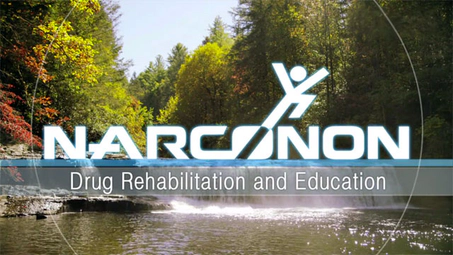Hungary’s Drug and Alcohol Abuse Situation
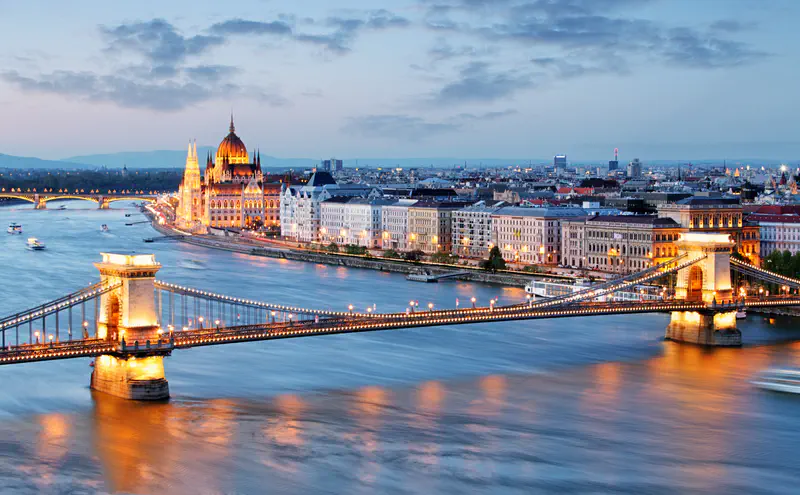
Despite Hungary’s long history, lush forests and shining rivers, it is subject to the same assault by drug abuse and addiction as its EU neighbors. Like several other Eastern or Central European countries, Hungary lies on the main drug trafficking route that reaches from Afghanistan to Northern Europe.1 Every country traversed by this route tends to be infected by the presence of the drugs passing through.
Cannabis
Only 3.5% of Hungarians use cannabis but it is responsible for 63% of addiction treatment arrivals.2 According to the European Drug Report of 2017, approximately 80% of those going to treatment for cannabis were referred by the courts in 2015, which undoubtedly still accounts for the high proportion of those entering treatment for cannabis.3
Vastly more herbal cannabis is seized in this country than any other drug. Nearly 3,800 kg were seized in 2017, while only 114 kg of cannabis resin and 24 kg of amphetamine were seized.
More than 3,000 people seek treatment for cannabis addiction each year, with most of these people starting treatment for the first time. Nine times as many men enter treatment compared to women. It is typical for a person to begin to use cannabis when they are nineteen years of age, but not enter treatment until they are 26.
Opioids and Drug-Involved Deaths
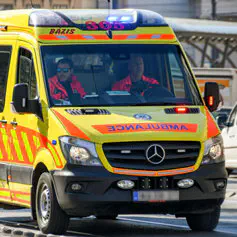
The EMCDDA estimates that there are approximately 3,200 high-risk opioid users in the country.2 Before 2010, the purity of the heroin on the illicit market resulted in a higher number of fatal drug overdoses. In 2011, there began to be a scarcity of heroin on the market and drug deaths fell. Soon, however, the numbers went back up as other opioids began to be substituted for heroin.
By 2017, some type of opioid was found in nearly a third of all drug deaths, usually in combination with other drugs. Rare is the addicted person who only uses one type of drug. In those cases that did not include an opioid, amphetamine, cocaine, ecstasy or synthetic cathinones or cannabinoids were the drugs most frequently detected.
According to the most recent analysis, about five people per million are lost to drug-related causes, far below the EU average of 22 per million. This places Hungary near the bottom of the EU list for drug-related deaths. Nearly all of these losses are male, with more than 50% coming from those aged 25 to 39.
The Rise of New Psychoactive Substances
In the chart below, you can clearly see the drugs sending people to treatment programs in Hungary. The rise of the “other drugs” category would include amphetamine and new psychoactive substances (NPS). The category NPS refers to the hundreds of synthetic drugs that have arrived on the illicit market in the last decade, including mephedrone, alpha-PVP, MDPV, and methoxetamine. Some are stimulants, some are synthetic cannabinoids and others are synthetic cathinones, drugs that have effects that resemble those of the psychoactive plant khat.
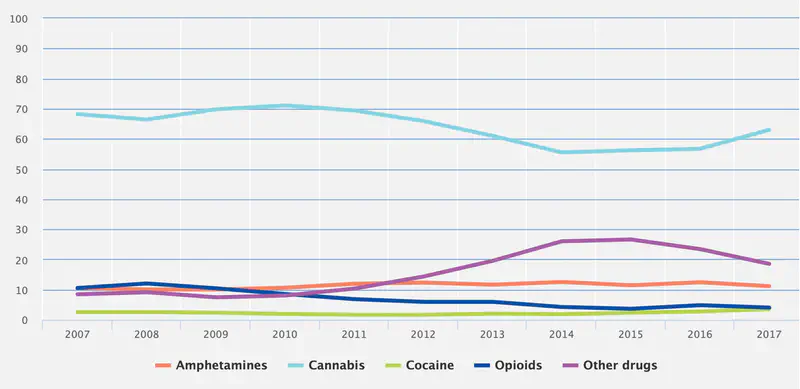
Courtesy of the European Monitoring Centre for Drugs and Drug Addiction
For some people, NPS have replaced their usual drugs of abuse. According to the European Monitoring Center for Drugs and Drug Addiction (EMCDDA), about half of those people participating in a needle exchange programme in 2010 said that they were injecting heroin and the other half said they were injecting amphetamine.4 By 2014, more than two-thirds of the people in these programs said that they were primarily injecting an NPS.
Unlike other EU countries, Hungary has some groups of people for whom NPS are the primary drugs they consume. In other EU countries, an NPS is a secondary or tertiary drug, only used when their preferred drug is unavailable or when they want to modify the effect of the drug they are using. In Hungary, synthetic cathinones such as mephedrone, MDPV and pentedrone may be substituted for heroin when that drug is scarce.1
Synthetic cannabinoids in particular are completely unpredictable and have very harsh effects on the user. One of their effects is a worsening psychiatric condition, including anxiety, depression and self-harm. Some people who switched from heroin to NPS deteriorated so much that they returned to heroin use when they could. Violence, aggression and homelessness are also associated with their use.
While the EMCDDA estimates that there are about 3,200 high-risk opioid users, there are an estimated 6,700 high-risk injecting drug users, with the remainder mostly injecting NPS.
Cocaine
Cocaine sends fewer than 200 people to treatment each year, with five times as many men entering programs as women. While this is a low number it has risen steeply in the last several years. Less than 1% of Hungarians use cocaine each year.
Amphetamine and Stimulants
Central and Eastern Europe see more amphetamine use than most of the rest of Europe.2 In Hungary, only 1.4% of the people use the drug but 11% of those entering treatment cite amphetamine as their primary addiction. More than 500 people entered treatment programs for amphetamine addiction in 2017, a number that has been steadily increasing since 2008.
More young adults (ages 15 to 34) use the stimulant ecstasy than amphetamine (2.1% compared to 1.4%).
Alcohol
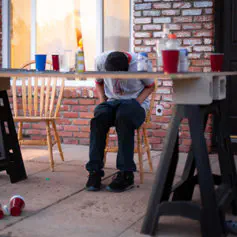
Across the EU, the average consumption of alcohol was 9.8 litres of pure alcohol in 2016.5 That same year, the average consumption among Hungarians was 11.4 litres, just 16% higher. But look at how much alcohol is consumed by Hungarian men who do, from time to time or more frequently, drink alcohol. This group drinks 24 litres per year.
If you take these figures and do the math, the average Hungarian who drinks consumes nearly seven drinks a day. That’s seven beers or seven shots of liquor or seven glasses of wine every day for the entire year. Two-thirds of these men (aged 15 and older) also drink heavily at least once a month. This is in line with other Eastern European countries, but more than other EU regions.
Men drink nearly three times as much alcohol as Hungarian women do. Nearly four out of ten Hungarian men drink enough to harm their lives, but only one in 14 women do. The World Health Organization (WHO) estimates that more than 16% of men are dependent on (addicted to) alcohol.
The WHO: also calculates how much harm to health and life is caused by alcohol consumption in Hungary.6 Of cases of cirrhosis of the liver, more than three out of four cases among men and 60% of women’s cases are caused by excessive consumption of alcohol. Nearly half of men’s traffic injuries and a third of women’s injuries can be attributed to alcohol.
Treatment in Hungary
Funds for treatment of the addicted come from the National Health Insurance Fund.2 According to one analysis of the funds spent on anti-drug activities, 75% went into law enforcement and only 10% to helping people recover from addiction.
Opioid substitution treatment for those addicted to heroin or similar drugs has been occurring in Hungary since 1994.2 Initially, only methadone was offered, until 2007 when buprenorphine began to be prescribed. Only about 20% of those in treatment receive buprenorphine which can be prescribed by any psychiatrist. Fewer than 700 people across the country are receiving opioid substitution treatment.
The World Health Organization reports that between 4,000 and 5,000 people are in treatment for any type of addiction at any one time.6 Treatment programs vary from inpatient and outpatient, housing for those in recovery, online programs, social services support, therapeutic communities, crisis intervention and specialized drug treatment units. Most treatment takes place in specialized drug treatment centers.
The United Nations Office on Drugs and Crime reports that Hungary has a high rate of tranquilizer and sedative misuse—9.5% which is more than most EU countries.6 However, this high rate of use does not seem to be reflected in the numbers entering treatment programs.
With a remarkable 75% of their anti-drug budget dedicated to law enforcement activities and only 10% devoted to treatment, it’s possible that Hungary may continue to suffer problems related to drug abuse and addiction that could be overcome. More focus on education, prevention and treatment might mean that their budget for law enforcement would not need to be quite so high.
Sources:
-
European Monitoring Cenre for Drugs and Addiction (2019), “Hungary—Country Drug Report 2019”. EMCDDA Report (PDF) ↩︎ ↩︎
-
European Monitoring Centre for Drugs and Drug Addiction (2017), “Drug related harms and responses”. European Drug Report 2017 ↩︎ ↩︎ ↩︎ ↩︎ ↩︎
-
European Monitoring Centre for Drugs and Drug Addiction (2017, June), “High-risk drug use and new psychoactive substances”. Results from an EMCDDA trendspotter study (PDF) ↩︎
-
Hungarian news article (2019), “Worlds most popular drug smuggling route goes right through Hungary”. Daily News Hungary article ↩︎
-
World Health Organization (2018), Global Alcohol report: Hungary (PDF) ↩︎
-
United Nations Office on Drugs and Crime (2019), “Annual prevalence of drug use (latest year available) relative to the 2019 global estimate”. UNODC Hungary, Drug demand ↩︎ ↩︎ ↩︎
